Within the rich tapestry of Minnesota’s botanical landscape, you can find an assortment of plants that may secretly harbor toxic and dangerous qualities. Though captivating, these venomous florae demand vigilance and knowledge due to the potential hazards they pose to both humans and animals. While they may often look inconspicuous, knowing how to identify these plants is crucial to avoid the danger that comes with touching or eating them.
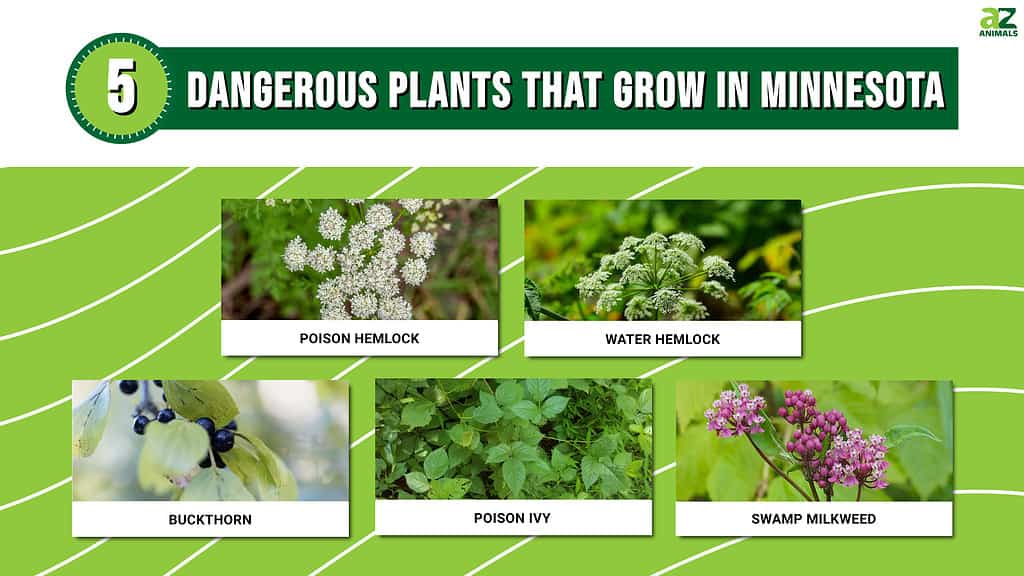
This article will delve into several notable poisonous plants that thrive within the state of Minnesota. We will explore their distinctive appearances, preferred habitats, and toxic properties.
5 Dangerous Plants that Grow in Minnesota
Poison Hemlock (Conium maculatum)
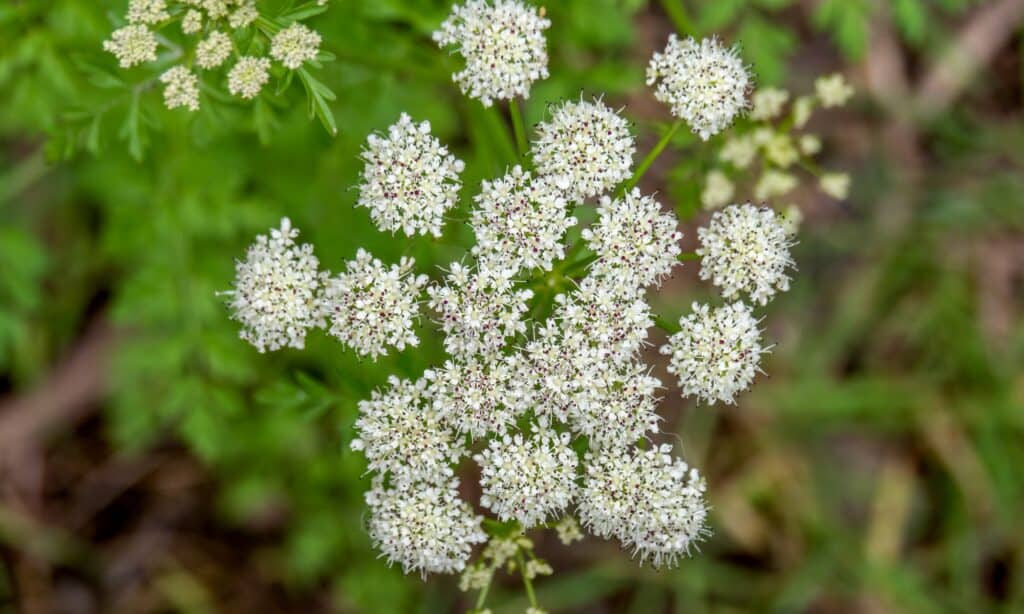
Poison hemlock is a highly poisonous plant that grows in Minnesota, identified by its small, white, umbrella-shaped clusters of flowers.
©iStock.com/Goldfinch4ever
Poison hemlock is an extremely poisonous plant indigenous to Europe and North Africa. This dangerous plant has subsequently spread to different parts of the globe, including Minnesota.
Belonging to the Apiaceae family, the poison hemlock shares this categorization with edible and harmless plants such as parsley, carrots, and celery. A biennial plant, poison hemlock generally grows to a height of 4 to 10 feet. In its initial year, it forms a low-lying rosette of leaves, while in the second year, it develops a tall, upright, and branching stem. The plant has distinctive sleek, hollow, stiff stems, frequently marked with reddish-purple spots or streaks. Its leaves are sizeable, finely divided, and feathery, resembling those of parsley or carrot plants. Poison hemlock produces small, white, umbrella-shaped clusters of flowers (umbels) that bloom from late spring to mid-summer.
This adaptable plant can be found in various habitats, such as damp meadows, stream banks, abandoned areas, and roadsides. It thrives in moist, well-drained soils and tolerates a wide range of soil types, including clay, loam, and sandy soils. Poison hemlock can grow in both full sun and partial shade conditions.
Although native to Europe and North Africa, poison hemlock has naturalized in numerous other regions worldwide. It is now commonly encountered in the United States, particularly in the western and eastern regions.
The peril associated with poison hemlock arises from the existence of toxic alkaloids, primarily coniine, and gamma-coniceine. These toxins are present throughout the plant, with the highest concentrations found in the seeds, roots, and young leaves. Even minimal ingestion of the alkaloids can result in severe poisoning for humans and animals, leading to symptoms such as muscle paralysis, respiratory failure, and potentially fatal outcomes in some cases. The toxic compounds may also cause skin irritation and rashes upon contact.
Despite all this, it’s worth noting the significant historical and cultural significance this toxic plant holds. Notably, the plant was used in ancient Greece as a means of execution for criminals, including the philosopher Socrates, who was sentenced to death by drinking a poison hemlock concoction.
To prevent unintentional incidents of poisoning, it is crucial to exercise caution and refrain from ingesting any part of the poison hemlock plant or mistaking it for edible plants like wild carrots or parsley. Accurate identification and awareness of the plant’s toxic properties are vital for personal safety.
Water Hemlock (Cicuta)
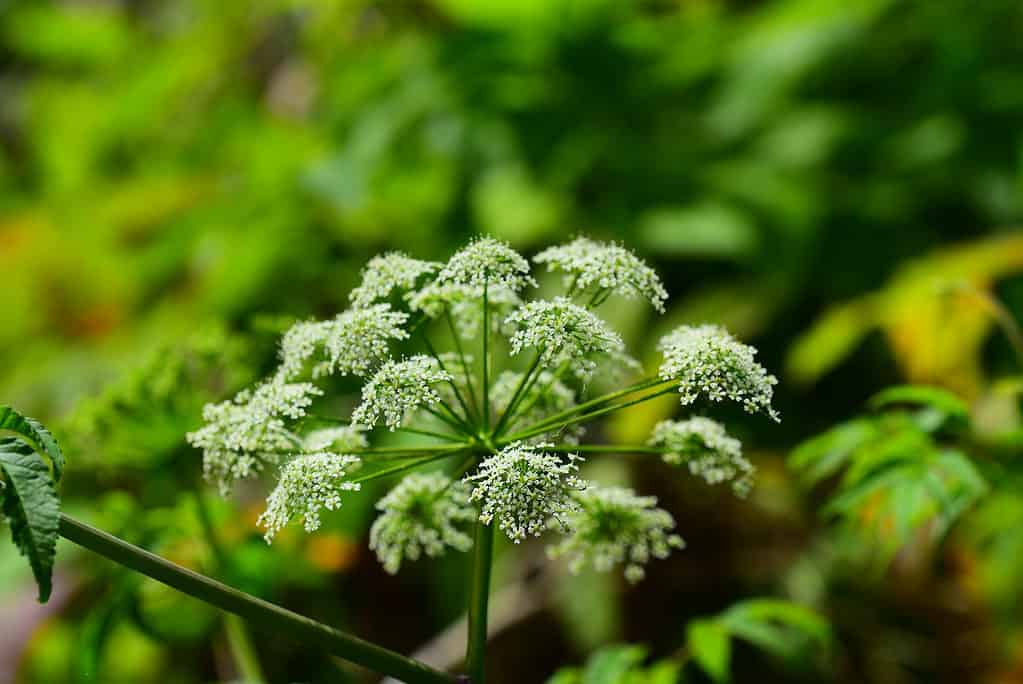
Another dangerous plant in Minnesota is water hemlock which is regarded as one of the most toxic plants in North America.
©iStock.com/cturtletrax
Water hemlock, also identified as spotted water hemlock, is an exceedingly toxic plant that presents a substantial danger to both humans and animals alike. Just like its relative, the poison hemlock, its appearance comprises towering, upright stems adorned with clusters of petite white flowers characterized by an arrangement resembling an umbrella. However, this deceitful beauty conceals the dangerous nature of the plant.
Water hemlock thrives in watery habitats like swamps, stream banks, and damp meadows. It tends to favor areas with fertile, loamy soil but can adapt to various soil types, including clay and sandy substrates. While partial shade is tolerable, water hemlock generally flourishes in sun-drenched areas.
You will likely encounter water hemlock throughout North America, including in Minnesota. It is distributed throughout a significant portion of the continent, growing in regions ranging from the United States and Canada to the Rocky Mountains and Pacific Northwest. Its presence can be widespread in damp environments where it finds the ideal conditions for growth.
Despite its seemingly innocent appearance, water hemlock is regarded as one of the most toxic plants in North America. It contains several highly poisonous compounds, notably cicutoxin, which detrimentally affects the nervous system. As a result, the ingestion of any part of the plant, especially the roots, can result in severe and potentially fatal consequences. The toxins have the ability to swiftly disrupt normal bodily functions, causing convulsions, respiratory failure, and even death.
Water hemlock has historically been used for medicinal purposes by indigenous peoples of North America. Native American tribes used water hemlock for treating ailments such as headaches, skin infections, and digestive problems. However, using water hemlock for medicinal purposes is highly dangerous and is not recommended due to the high toxicity of the plant.
To really highlight the need for caution around this plant, it must be noted that water hemlock’s toxins can be lethal even in tiny quantities. Even accidental ingestion or contact with fragmented plant parts can have dire consequences.
Buckthorn (Rhamnus cathartica)
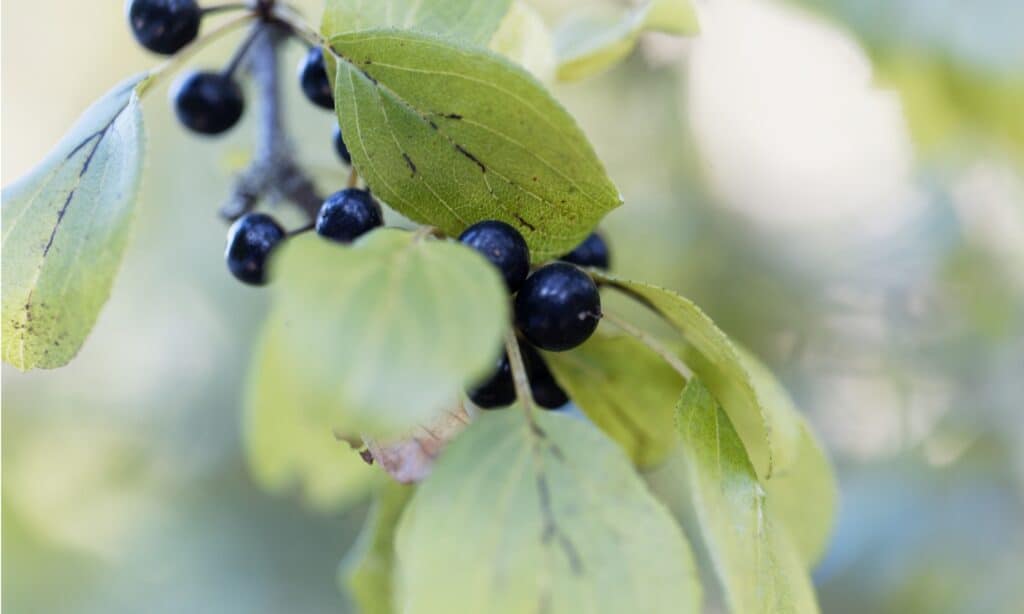
Buckthorn is considered dangerous due to its toxicity, but also because it outcompetes native vegetation.
©iStock.com/weisschr
Buckthorn is a poisonous plant commonly found in Minnesota and known for its deceptive beauty, but its presence can pose significant risks. Its appearance is characterized by dense shrubs or small trees with glossy, dark green leaves and clusters of small, round berries that transition from green to black when ripe.
Buckthorn has a versatile nature when it comes to its growth habitat. It can be found in various regions, including woodlands, thickets, and forest edges. This adaptable plant can tolerate different soil types, ranging from sandy to loamy, although it generally prefers well-drained soils. While it can tolerate partial shade, buckthorn thrives in areas with total sun exposure.
This toxic plant is commonly found in North America and Europe, where it has become invasive in certain areas. Due to the buckthorn’s invasive nature, it often outcompetes native vegetation, leading to a decline in biodiversity. So, this toxic plant is dangerous in more ways than one!
But mainly, buckthorn is considered dangerous due to its toxicity. The plant contains various compounds, including anthraquinones, which can have a laxative effect on the digestive system. As a result, ingesting the berries or other plant parts can cause gastrointestinal distress, including diarrhea and vomiting. Furthermore, the seeds contain compounds that inhibit the germination of other plants, contributing to the plant’s invasive nature.
While buckthorn can cause gastrointestinal distress if ingested, it is important to note that the toxicity of the plant is relatively low compared to other poisonous plants. Ingestion of small amounts of the berries or leaves is unlikely to cause serious harm, although it may cause discomfort. However, consuming larger amounts can lead to more severe symptoms, such as abdominal cramping and dehydration.
Poison Ivy (Toxicodendron radicans)
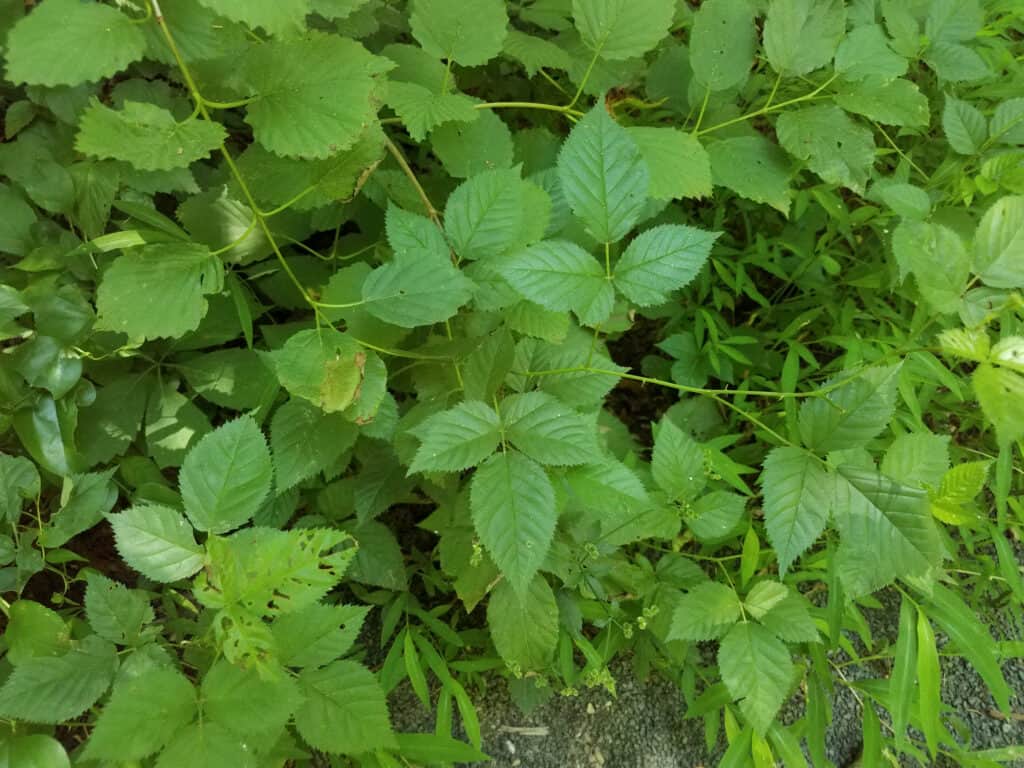
Poison ivy is considered dangerous due to its potent allergenic properties.
©iStock.com/Justin Smith
Poison ivy is a poisonous plant notorious for its irritating effects and distinct appearance. Its appearance consists of a shrub or climbing vine with three glossy and green leaflets during the spring and summer, transforming into vibrant shades of red, orange, or yellow during the fall months. The stems of the climbing form of this plant give this plant a “fuzzy” look.
This toxic plant is predominantly found in North America, particularly in the United States and Canada. It thrives in various environments, including woodlands, forests, open fields, and meadows. Poison ivy grows in well-drained soils, ranging from sandy to loamy. It tolerates different light conditions but prefers partial shade or filtered sunlight.
You may likely encounter poison ivy in areas with suitable growing conditions. It is commonly found along hiking trails, in forests, and at the edges of wooded areas. The plant’s ability to spread through seeds and root sprouts contributes to its prevalence in these environments.
Poison ivy is considered dangerous due to its potent allergenic properties. The plant contains an oily resin called urushiol, which can cause severe skin irritation and allergic reactions in humans. Direct contact with any part of the plant, including leaves, stems, and roots, can lead to a red, itchy rash accompanied by blisters. In addition, the urushiol oil can remain active on surfaces, such as clothing or pet fur, increasing the risk of unintentional exposure.
The plant’s ability to induce a painful allergic reaction makes it a hazard for individuals who come into contact with it. Even slight contact with poison ivy can trigger a rash in susceptible individuals. Moreover, the resin can be released into the air when the plant is burned, posing a risk of respiratory irritation and allergic responses.
Due to its toxic effects, it is crucial to be able to identify and avoid poison ivy. Recognizing the plant’s distinctive three-leaflet pattern and taking preventive measures, such as wearing protective clothing when out and washing exposed skin thoroughly, can help minimize the risk of exposure and subsequent allergic reactions. However, it’s worth mentioning that not everyone is allergic to urushiol. But with that said, it’s estimated that up to 85% of people are sensitive to it, and repeated exposure can increase one’s sensitivity to it over time.
Swamp Milkweed (Asclepias incarnata)
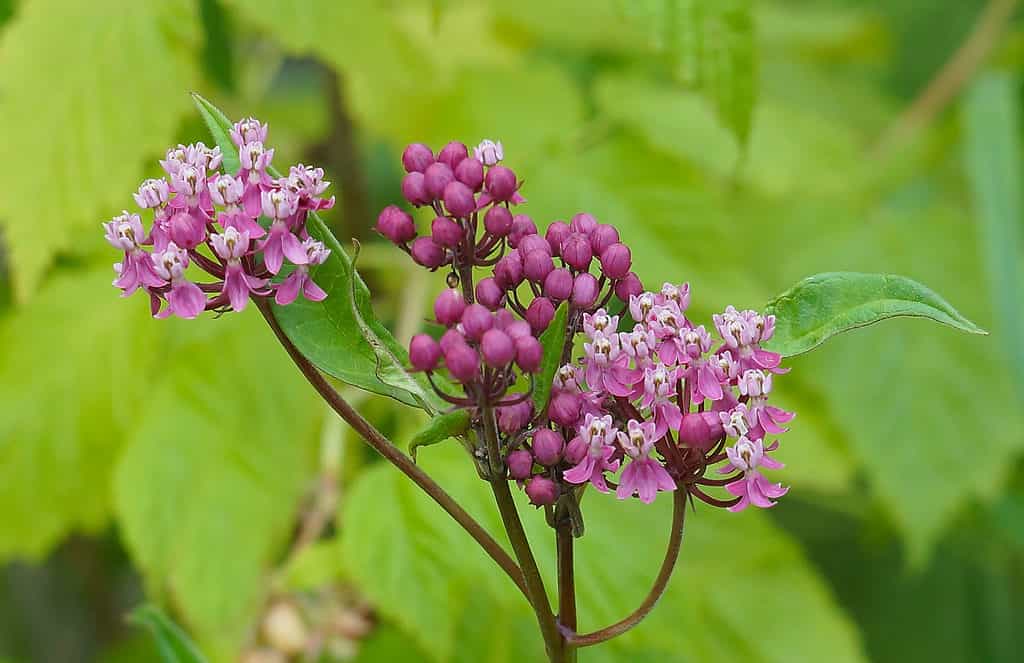
Swamp milkweed produces bright pink flowers but can cause health problems in humans and animals if ingested in significant quantities.
©ttoleg/Shutterstock.com
Swamp milkweed is a toxic plant with distinctive attributes that thrives in wetland ecosystems. Its appearance showcases tall, slim stems adorned with clusters of vivid pink flowers, forming a remarkable spectacle. Swamp milkweed commonly reaches a height of 2 to 4 feet. However, notwithstanding its aesthetic appeal, this plant harbors poisonous and dangerous characteristics.
Swamp milkweed predominantly flourishes in wetland habitats, encompassing marshes and swamps along the perimeters of ponds or streams. It favors moist or saturated soils. This adaptable plant can flourish in various soil compositions, ranging from sand to clay. It thrives in full-sun areas but can tolerate partial shade.
Encounters with swamp milkweed are most likely in North America, specifically in regions teeming with wetland ecosystems. It is frequently encountered in the United States, including Minnesota, and parts of Canada as well. Wetlands, alongside their associated flora, offer an optimal environment for swamp milkweed to thrive.
While swamp milkweed is recognized as a poisonous plant, its toxicity is relatively moderate when juxtaposed with other venomous plants. The plant contains cardiac glycosides that can impinge on the heart and cardiovascular system if ingested in substantial quantities. The risk of severe poisoning resulting from inadvertent ingestion is relatively low. Nevertheless, caution should be exercised, particularly when dealing with susceptible individuals or animals. And although the toxicity is relatively mild, it can still cause health problems in humans and animals if ingested in significant quantities. Symptoms of poisoning may include nausea, vomiting, diarrhea, abdominal pain, and even irregular heartbeat.
Despite its mild toxicity, swamp milkweed is crucial in fostering biodiversity. It serves as a vital host plant for monarch butterflies, providing indispensable habitat and abundant sustenance for their delicate caterpillars. The toxic attributes of the plant effectively safeguard the monarchs, acting as a formidable defense mechanism against potential predators, thus forging a mutually advantageous and resilient ecological association. Furthermore, this remarkable plant plays a pivotal role in supporting the delicate balance of ecosystems by attracting a diverse array of pollinators, contributing to the overall health and vitality of the surrounding flora and fauna.
Summary of 5 Dangerous Plants that Grow in Minnesota
| Number | Dangerous Plant |
|---|---|
| 1 | Poison Hemlock |
| 2 | Water Hemlock |
| 3 | Buckthorn |
| 4 | Poison Ivy |
| 5 | Swamp Milkweed |
Thank you for reading! Have some feedback for us? Contact the AZ Animals editorial team.








